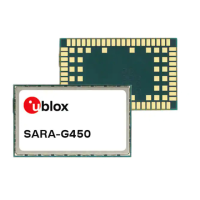SARA-G450 - System integration manual
UBX-18046432 - R08 Design-in Page 90 of 143
C1-Public
SARA-G450
C1
FIRST
SIM CARD
VPP (C6)
VCC (C1)
IO (C7)
CLK (C3)
RST (C2)
GND (C5)
C2 C3 C5
J1
C4
D1 D2 D3 D4
GND
U1
41
VSIM
VSIM
1VSIM
2VSIM
VCC
C11
4PDT
analog
switch
3V8
39
SIM_IO
DAT
1DAT
2DAT
38
SIM_CLK
CLK
1CLK
2CLK
40
SIM_RST
RST
1RST
2RST
SEL
SECOND
SIM CARD
VPP (C6)
VCC (C1)
IO (C7)
CLK (C3)
RST (C2)
GND (C5)
J2
C6 C7 C8 C10
C9
D5 D6 D7 D8
Application
Processor
GPIO
R1
Figure 46: Application circuit for the connection to two removable SIM cards, with SIM detection not implemented
Part number – Manufacturer
22 pF capacitor ceramic C0G 0402 5% 25 V
GRM1555C1H220JZ01 – Murata
1 µF capacitor ceramic X7R 0402 10% 16 V
GRM155R70J105KA12 – Murata
Very low capacitance ESD protection
PESD0402-140 – Tyco Electronics
47 kΩ resistor 0402 5% 0.1 W
RC0402JR-0747KL- Yageo Phycomp
SIM card holder
6 positions, without card presence switch
Generic manufacturer,
C707 10M006 136 2 – Amphenol
4PDT analog switch,
with Low On-Capacitance and Low On-Resistance
FSA2567 – Fairchild Semiconductor
Table 31: Examples of components for the connection to two removable SIM cards, with SIM detection not implemented
2.5.2 Guidelines for SIM layout design
The layout of the SIM card interface lines (VSIM, SIM_CLK, SIM_IO, SIM_RST) may be critical if the
SIM card is placed far away from the SARA-G450 modules or in close proximity to the RF antenna:
these two cases should be avoided or at least mitigated as described below.
In the first case, a too-long connection can cause the radiation of some harmonics of the digital data
frequency as any other digital interface: keep the traces short and avoid coupling with RF line or
sensitive analog inputs.
In the second case, the same harmonics can be picked up and create self-interference that can reduce
the sensitivity of GSM receiver channels whose carrier frequency is coincidental with the harmonic
frequencies: placing the RF bypass capacitors suggested in 2.5.1 near the SIM connector will mitigate
the problem.
In addition, since the SIM card is typically accessed by the end user, it can be subjected to ESD
discharges: add adequate ESD protection as suggested in 2.5.1 to protect the module SIM pins that
are close to the SIM connector.
Limit the capacitance and series resistance on each SIM signal to match the SIM specifications: the
connections should always be kept as short as possible.
Avoid coupling with any sensitive analog circuit, since the SIM signals can cause the radiation of some
harmonics of the digital data frequency.

